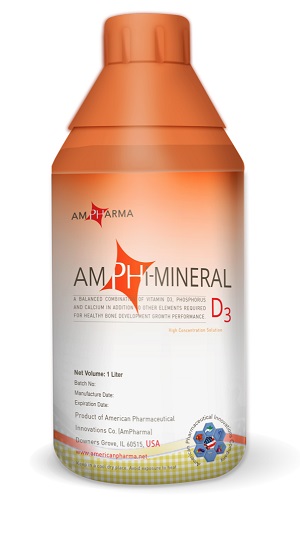AMPHIMINERAL-D3
Last Updated: Friday, February 3, 2023

A balanced combination of vitamin D3, phosphorus and calcium in addition to other elements required for healthy bone development and guarding against skeletal and leg problems in broiler chicken and other farm animals and to improve the growth performance.
Ingredients
Vitamin D3 (Cholecalciferol), Phosphorus, Calcium, Sodium, Iron, Manganese, Magnesium, Copper, Zinc
Product Description
- AMPHIMINERAL-D3 liquid is specially designed to supply all required elements for bone health and development. Vitamin D3 (Cholecalciferol) is a characteristic component that is essential for utilization of all other ingredients.
- AMPHIMINERAL-D3 liquid provides adequate calcium and phosphorus for laying hens and facilitates their bone deposition owing to its vitamin D3 content.
- AMPHIMINERAL-D3 liquid, therefore, helps maintaining the physical integrity of structural bone acing on skeleton cortical/trabecular bone. It also helps maintaining adequate mobile Ca pool for eggshell formation acting on medullary bone.
- AMPHIMINERAL-D3 liquid guard against osteoporosis and fractures by supporting structural bone development.
- AMPHIMINERAL-D3 liquid guards against common keel bone fractures during the laying period.
- AMPHIMINERAL-D3 liquid is characterized by its content of 1,25(OH)2D3 (the bioactive vitamin D3 metabolite) which is a key player in Ca-homeostasis together with PTH. 1,25(OH)2D3 is needed to increase Ca absorption from the intestinal tract and Ca mobilization from bone during eggshell formation and to restore it after eggshell formation is finished. 1,25(OH)2D3 is crucial for calcium homeostasis and bone metabolism. It also has direct effects on skeletal formation, as all cells related to skeleton formation (chondrocytes, osteoblasts, and osteoclasts) contain vitamin D3 receptors (VDR). 1,25(OH)2D3 stimulates bone matrix formation and bone maturation and enhances osteoclast activity. In addition, 1,25(OH)2D3 increases the activity of alkaline phosphatase and the expression of bone calcification genes in osteoblasts (cells required for bone synthesis and mineralization, both during the initial formation of bone and during bone remodeling), to maintain the concentration of Ca and P and promote ossification. Decreased levels of 1,25(OH)2D3 may cause decreased vascular invasion associated with reduced activity and thereby contribute to growth plate abnormalities such as tibial dyschondroplasia and rickets. As the basis is in the vitamin D3 metabolism, it is a better option to increase 1,25(OH)2D3 levels rather than dietary Ca to improve Ca homeostasis in ageing laying hens.
- AMPHIMINERAL-D3 liquid is an essential source of calcium and phosphorus for broilers and young chicks. The bird’s skeleton contains about 99% of the Ca and about 80% of the P in the body. AMPHIMINERAL-D3 liquid is of a special value for young chicks as mineral nutrition begins 10 to 12 days before the egg is laid and skeletal development begins during incubation, with embryonic bone growth reaching a plateau after 19 days of incubation. The absolute amounts of calcium and phosphorus were important for optimal growth and bone ash.
- AMPHIMINERAL-D3 liquid provides “trace minerals” essential to avoid deficiencies that cause disturbances in metabolic processes including loss of appetite, lower performance, impaired immune system, and reproductive disorders. Trace minerals including manganese (Mn), copper (Cu), and zinc (Zn) are essential in various body functions and optimal growth and health. Trace minerals are involved in several physiological, digestive, and biosynthetic processes within the body. They are cofactors in many enzymes and act as catalysts in enzyme system and participate in immune defense system and hormone secretion pathways. Trace minerals influence bone development, feathering, growth, and appetite.
- AMPHIMINERAL-D3 liquid provides optimal magnesium concentration for growing chicks. Magnesium (Mg) is a key dietary element and it was reported that Mg was indispensable for animal growth and survival. Clinically, as observed by many authors, Mg deficiency in growing poultry is characterized by poor growth and feathering, decreased muscle tone, incoordination, squatting, fine palpable tremors, convulsive attacks, coma, and death; in laying hens, symptoms include reduced egg production, hypomagnesemia, decreased feed consumption, nervous tremors, and seizures. Mg is involved in the metabolism of amino acids, fat and sugars and in bone Ca and vitamin D metabolism. Magnesium has essential functions in cellular metabolism and bone development. Its actions are closely linked to calcium and phosphorus, making the achievement of the right proportion of these elements in diets an important issue in poultry nutrition. Despite the fact that magnesium is adequately present in most plant-based diets, supplemental magnesium may positively affect poultry meat quality and body weight at certain developmental stages.
Product Benefits
- AMPHIMINERAL-D3 liquid is especially designed to help healthy bone development and to guard against nutritional skeletal disorders as rickets, osteomalacia and caged layer fatigue.
- AMPHIMINERAL-D3 liquid is of value to avoid leg problems in broiler chicken and other farm animals.
- AMPHIMINERAL-D3 liquid may be used to improve the growth performance.
- AMPHIMINERAL-D3 liquid is helpful to guard against osteoporosis and fractures in laying hens.
- AMPHIMINERAL-D3 liquid is helpful improve vascular invasion of bones in chickens and therefore, to guard against tibial dyschondroplasia and rickets.
- AMPHIMINERAL-D3 liquid may be used to prevent keel bone damage (KBD) in laying hens that compromises bird welfare and has a negative impact on production.
- AMPHIMINERAL-D3 liquid may be used in aged laying hens to reduce incidence of bone fractures.
- AMPHIMINERAL-D3 liquid may be used in cases of increased the demand for proper skeletal Ca stores such as early sexual maturation, alongside production of the first egg at a younger age and fast increase to peak production.

